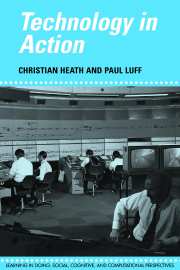Book contents
- Frontmatter
- Contents
- Preface
- 1 Technology and social action
- 2 Documents and professional practice: ‘bad’ organisational reasons for ‘good’ clinical records
- 3 Animating texts: the collaborative production of news stories
- 4 Team work: collaboration and control in London Underground line control rooms
- 5 The collaborative production of computer commands
- 6 ‘Interaction’ with computers in architecture
- 7 Reconfiguring the work space: media space and collaborative work
- 8 Organisational interaction and technological design
- References
- Index
3 - Animating texts: the collaborative production of news stories
Published online by Cambridge University Press: 22 September 2009
- Frontmatter
- Contents
- Preface
- 1 Technology and social action
- 2 Documents and professional practice: ‘bad’ organisational reasons for ‘good’ clinical records
- 3 Animating texts: the collaborative production of news stories
- 4 Team work: collaboration and control in London Underground line control rooms
- 5 The collaborative production of computer commands
- 6 ‘Interaction’ with computers in architecture
- 7 Reconfiguring the work space: media space and collaborative work
- 8 Organisational interaction and technological design
- References
- Index
Summary
The fact is that when the listener perceives and understands the meaning (the language meaning) of speech, he simultaneously takes an active, responsive attitude towards it, and understanding live speech, a live utterance, is inherently responsive, although the degree of this activity varies extremely.
Bakhtin (1986: 68)Introduction
It is increasingly recognised that recent developments in digital communications and broadcast technologies will have a wide-ranging impact on conventional news media. For example, we have already witnessed new, experimental television programmes in which on-line audiences can actively participate in programmes, and agreements are currently in place to facilitate new forms of co-operation between national broadcasters, newspaper publishers and telecommunication companies. In the short term, perhaps the clearest example of the ways in which digital technologies are affecting the ‘media’ is illustrated by the enthusiasm with which conventional newspapers, such as the Daily Telegraph, Le Monde and the New York Times are providing on-line new services alongside their conventional broadsheet. These services place considerable demands on those responsible for producing the news. Journalists and editorial staff have to produce new and attractive products; they have to shape news produced for one medium, such as newspapers, for another and, increasingly, they have to tailor, in some cases the same, material for particular types of reader.
For some companies, providing electronic on-line news services for a heterogeneous readership is by no means new.
- Type
- Chapter
- Information
- Technology in Action , pp. 61 - 87Publisher: Cambridge University PressPrint publication year: 2000



